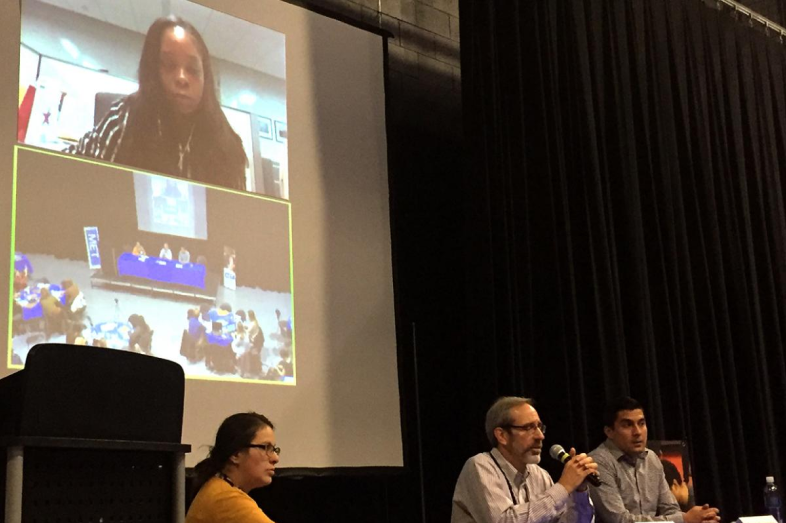

Recent work by journalists Erica Green, Jason Gonzales and Matthew Kauffman shows the importance of digging into the best-laid plans of a school district or state, whether it’s desegregation efforts or sending students to college for free.
Green of the New York Times, Gonzales of The Tennessean, and Kauffman of the Hartford Courant recently presented their work and gave fellow reporters tips on data usage and asking tough questions during a “How I Did the Story” session at EWA’s equity seminar in Providence, Rhode Island (Philissa Cramer of Chalkbeat served as moderator).
Kauffman said his newsroom regularly covered updates in an ongoing state court case — Sheff v. O’Neill – involving desegregation of public schools. But he wanted to take a deeper dive. Twenty years after the ruling, he said, politicians brag about progress.
“It still meant a majority of Hartford students, a generation on, were still in schools the (state) Supreme Court had declared were unconstitutional,” he said. (Kauffman recently left the Courant.)
The plan and the outcomes did not match up.
“This is not what the plan was 20 years ago, so we thought it was important to give a more sober look to it,” he said.
Shortchanging Students
The Courant’s series — which was co-reported for the Courant by Vanessa de la Torre (now with Connecticut Public Radio) — won a first-place prize for investigative reporting in the 2017 EWA Awards.
As de la Torre explained, “The Sheff plaintiffs argued a generation ago that the city schools’ high concentration of poor blacks and Latinos, of children from single-parent homes, of newcomers still learning English, had so overburdened the system that it shortchanged all students — the exact problems that district leaders reel off today when discussing the struggles of Hartford schools omitted from the Sheff remedy.”
Gonzales, along with fellow Tennessean reporter Adam Tamburin, looked at the impact of a statewide campaign to offer free community college tuition to qualified recent high school graduates. (The project was supported in part by an EWA Reporting Fellowship.)
Too often, he said, problems from the K-12 system in Tennessee, including a low rate of college readiness, were affecting students when they reached college. Getting into postsecondary institutions was not the same as completing a degree.
“What we found was even though this has benefited students in the state, there’s still a lot of problems there, especially in getting low-income and minority students to graduate, especially black students,” Gonzales said.
Reporting on Segregation
Green discussed two stories of hers—one from The New York Times in the fall of 2018 about segregation in Charlottesville, Virginia, and the other on the same topic in the Baltimore Sun in 2017.
For the “Bridging the Divide” project in The Sun, Green said the goal was to look at why segregation was so persistent. (The series was also supported by an EWA Reporting Fellowship, and co-authored by Baltimore Sun education reporter Liz Bowie.)
“We wanted to get into the personal and political will to desegregate,” she said.
In Charlottesville, Green said residents often viewed their city as progressive, but inequities abound.
“It was really stark, the inequities, especially in terms of access that black and white students had there,” Green said. “In a place that had such entrenched and historic segregation and a history of racism and discrimination, it was just rich ground to look at it there.”
Green’s advice to fellow reporters was to push back on sources who use language that is vague when they talk about race and segregation, including statements like “I don’t want my school’s culture to change.” Reporters should ask what that means to them, and why they think it would change if boundaries were redrawn.
Asked about how to organize work on a long-term project, Green said she relies heavily on making outlines. While that “sounds so basic,” the value of fundamentals like that shouldn’t be overlooked in the planning process, she said.
Tapping Data to Tell the Story
The three journalists also gave their best advice on how to use data in their stories.
All three reporters recommended partnering with researchers, universities or other organizations to crunch numbers, if working on a project that includes significant data analysis.
Green partnered with ProPublica, a nonprofit news outlet, for the story on Charlottesville. Kauffman worked with stats.org, and Gonzales and Tamburin worked with researchers at Vanderbilt University to create a map of data that showed the percentages of people with a college degree in each zip code in Tennessee.
Kauffman said data doesn’t have to be difficult to work with, and reporters shouldn’t assume it’s beyond their scope — even if math isn’t their strong suit. And data skills are useful in a newsroom, he added.
“Learn a little bit of Excel, and you’ll guarantee employment,” Kauffman said.
He also recommended finding people who are in the know about a certain topic from a historical perspective. That’s harder to do these days within the journalism industry, he said.
“Newspapers are losing institutional knowledge,” Kauffman said. “It’s not as easy to go to the crotchety person in the corner on the typewriter and go, ‘Educate me.’”
*This post has been updated to reflect Vanessa de la Torre’s contributions to the Harford Courant’s project “More Separate, Still Unequal.”